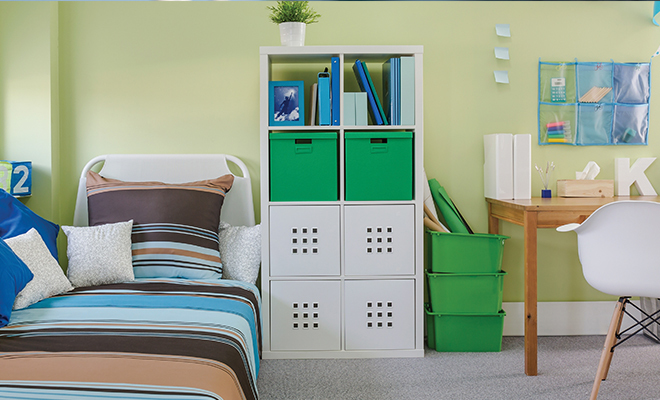
Ten Ways to De-clutter the Children’s Rooms
A life with children will always be slightly messy and disorganized, but there are tactics to keep the mess minimal and the chaotic situations manageable.
Take a peek at these ten ways to help de-clutter your children’s rooms which includes having them help with the process. They will be learning good habits for the future benefit of your organized household.
1. Which items are really important?
Identify clothes, toys and other items that are truly important to you and your kids. Take inventory of what toys they currently play with, sincerely enjoy and honestly love. Then, it’s time to ditch the rest of it. Start with one section, creating a pile for keeps, a pile for donating and a pile for trashing. Put the “for keeps” stuff back in its proper place then move on to the next section.
A great time to take inventory of your children’s room and get rid of the excess stuff is during Christmas and birthdays. These two occasions bring in tons of new toys, clothes and accessories.Make room for these new items by cleaning out the old stuff.
Besides these big overhauls, do some simple de-cluttering once a month to keep up with the upkeep instead of saving it all for the big dates.
A final tip here: leave some space. As you are putting items away, don’t feel as if you have to fill up every drawer, bin, cubby or shelf. Leave some space around objects for a nice, clean and organized look.
2. Constrain the mess.
Keep the kids’ messes restricted to their rooms. Do not let the chaos spread across the entire house. If they want to play with something in the living room, let them choose one item and then require them to put it back before pulling out another toy.
3. Organize the mess.
Try using bins and cubical storage to keep things organized. Bins, with or without lids, make it easy for kids to toss their stuff into without a lot of work or thought. Keep the process simple. Add labels when possible. A picture on the front will help young kids relate to what is supposed to go in that bin. These bins are great for small pieces such as race cars. Cubbies and cubical storage allow for vertical organization for games, puzzles and stuffed animals.
4. Designate a location for every toy.
A great organizing solution is to make sure everything has a particular place of storage. Try keeping similar items together to make it easy for children to remember which items go where. Think balls in one bin and beach toys in another.
Try painting a dresser in chalkboard paint and writing and/or drawing pictures on the drawers to label socks, underwear, T-shirts, etc.
5. Teach your children to clean up after themselves.
Children can learn to clean up after themselves at a young age. So instead of constantly running around and picking up after everyone, just ask your kids to pick up their toys after they are done using them. Yes, a new mess will occur sooner rather than later, but at least the kids are helping out. Plus, these good habits will increase as they get older.
6. It’s okay to let your children make messes.
Recognize that messes are unavoidable and it is okay as long as it gets cleaned up. Don’t punish them for making the mess. That is not the issue. Cleaning up after the mess is the important step.
7. Buy less stuff.
As a parent, you need to learn how to resist buying your kids every little thing that is cute or engaging. Teach your kids that less is more and that the huge piles of stuff in their room are not necessary to be happy. Bonus: less stuff to rummage through allows your kids to find the things they want to play with easily.
Tip: Choose quality over quantity so that you have less broken plastic pieces that get discarded to the junk pile.
8. Designate short clean up routines.
Instead of letting messes pile up, learn to clean as you go. When you make a mess, clean it up. Same goes for your kids. That way the house does not turn into a wreck.
Also, designate a few minutes each day for quick clean-ups. Many people utilize the time right before bed to get a few things picked up off the floor. It will make for a pleasant morning.
When it’s time to thoroughly clean the house, designate tasks to all family members and then set a timer. See if everyone can get their designated task completed within the allotted time frame. The faster the chores get done, the more time you have to relax and have a family fun day.
9. Create a space for school papers.
The plethora of incoming school papers, especially if you have multiple kids, can get disorganized and important dates and field trip release forms can get lost quickly.
Create an inbox for all incoming papers, a second box for current matters that need attention and then file the rest away. Keep one or two folders so that you do not have to search for papers if you need them at a later time.
10. Accept that no child is perfect at cleaning up.
A minimal life doesn’t exist when you have kids. Learn to accept that the rest of the household may not be great at cleaning up and that harping on every little thing is not nearly as fun as enjoying family time. HLM








